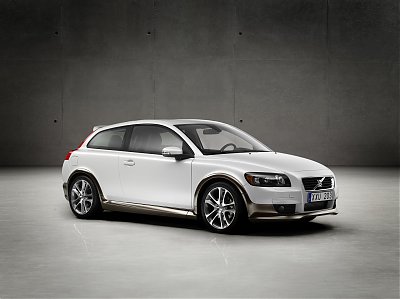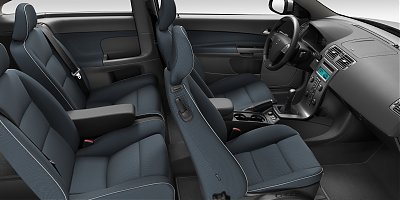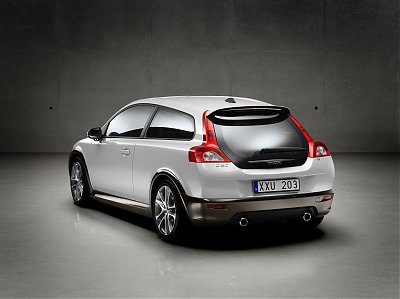
Compact and dynamic, the C30 is the smallest car in Volvo’s model range.
With a compact body, sporty chassis, and powerful engines, it offers a dynamic
driving experience.
The interior, which is designed with a number of refinements, offers a high
level of comfort and flexibility. For example, the rear seats are versatile as
well as comfortable.
Consistent with Volvo's priority on safety, the C30 has been
developed to be a safe car. The objective is: best in class!
“The compact format has not prevented us from integrating much of what is
best in the larger Volvo cars,” says Håkan Abrahamsson, Project Director for the
C30. “Even the smallest Volvo should provide the right premium feel – in all
respects. This applies to its design, its quality and how the C30 drives. Our
intention is that the Volvo C30 should attract people who love driving.”
Manoeuvrable and sporty to drive
As expected from a car
that is more compact and lighter than the S40 sedan, the Volvo C30 is very
nimble. In a segment where proportion and size do matter, and the C30 measures
just 4,250 mm in overall length – 220 mm shorter than the S40 sedan.
The compact and rigid body structure overlays a wide track and
relatively long wheelbase. This yields a short front and rear overhang and
versatile interior space.
The C30's platform is perfect in allowing for excellent interior space and in
providing stable driving characteristics. The chassis, with coil-over strut
front suspension and a multilink rear suspension, delivers balance and direct
feel to the driver.
Precise body control and quick response with positive driver feedback are key
properties to the C30's on-road dynamics.
DSTC (Dynamic Stability and Traction Control) is standard on 162 kW C30 T5
while STC (Stability and Traction Control) is standard on the 125 kW C30 LE.
Since the mid 90s, Volvo has provided stability and
traction control as a standard driver aid.
Wide range of efficient engines
Pick your engine. The
Volvo C30 can be powered by a range of four and five-cylinder petrol and diesel
engines. Most potent are the 162 kW, 320Nm T5 petrol engine and the 136 kW, 350Nm
D5 diesel engine. The D5 produces 30 Nm more than the petrol T5, while the two
engines do share five-speed automatic or six-speed manual.
“Thanks to the sporty chassis and the car’s light weight (curb weight
1,204-1,404 kg), it is very sporty,” says Abrahamsson. “And the range of engines
will meet all customers’ demands.”
All engines have four-valve technology and double overhead camshafts, which
contribute to the quick response and good high-speed characteristics.
Range of engines for Australia
| Petrol engines |
Configuration |
Output kW |
Torque Nm |
| T5 (2.5 litres) |
In-line 5-cyl turbo |
162 |
320 |
| 2.4i |
In-line 5-cyl |
125 |
230 |
Diesel engines (yet to be confirmed)
| D5 (2.4 litres) |
In-line 5-cyl turbo |
132 |
350 |
| 2.0D |
In-line 4-cyl turbo |
100 |
320 |
Engine facts in brief:
- All engines are extremely compact and transversely mounted to offer maximum
occupant protection and cabin space.
- Turbo technology is used on the T5 engine and on all diesel engines to
provide the best possible on-road driving performance.
- Volvo's six-speed manual gearbox accompanies the T5 turbocharged petrol, D5
turbocharged diesel and 2.0D turbocharged diesel engines.
- A five-speed Geartronic automatic gearbox is available with Volvo's
five-cylinder petrol and diesel engines – T5, D5 and 2.4i.
- An exhaust particulate filter is available with all diesel engines. It very
effectively removes soot particulates from the exhaust gases, with filtration
efficiency above 95 percent. The filter is a CDPF – Coated Diesel Particulate
Filter – in which a special coating helps burn the particulates.
Smart functions offer great comfort and
flexibility
Despite its compact exterior and format, the Volvo C30
interior is comfortable and able to seat four adults. The interior space
is maximised by the unique two-seat front and two-seat rear layout.
The front seats are ergonomically designed and offer a correct and relaxing
seating position. Each front seat moves forward easily for convenient access to
the rear seat. The tapered design of the B-pillar also contributes to rear seat
entry and exit.

The new C30 has room for four adults with generous headroom and legroom. The
separate rear seats are slightly centred to provide a feeling of space and
provide good forward view. It also makes communication between front and rear
occupants easier.
The rear seat backrests are individually foldable. Folding can be easily done
when standing behind the car as well as from the passenger compartment.
The glass tailgate is very convenient and easy to open and close. It offers
good access to the cargo compartment. To keep items in the cargo compartment
from view, two load covers are available: a soft and a hard version.
Air conditioning and air quality system for a pleasant cabin
climate
To provide a pleasant cabin climate, air conditioning and a
pollen filter are standard in the Volvo C30. Alternatively the car can be
specified with ECC (Electronic Climate Control), which is automatically
controlled and the chosen cabin temperature is kept constant regardless of the
outside temperature. Furthermore, it is possible to set the temperature
individually for the right and left sides.
The ECC system can be supplemented by IAQS (Interior Air Quality System),
which continuously monitors the carbon monoxide level of the incoming air and
closes the air vents when the level is too high for the in-cabin climate comfort
and health of the occupants of the car.
The IAQS system includes an active charcoal filter to prevent dust, exhaust
particles, pollen and unpleasant odours from entering the cabin through the
ventilation system.
World-class audio with deep bass and an extra
connector
“We have chosen to give the C30 one of the very best
factory-fitted audio systems in the world,” says Abrahamsson. “And the special
body, with wide doors and deep side panels in the rear, has proven to provide an
extra dimension for the sound, with extreme depth and powerful bass
reproduction.”
There are three audio systems:
- Performance – a 4 x 20 W amplifier and 4 loudspeakers
- High Performance – a 4 x 40 W amplifier and 8 loudspeakers
- Premium Sound – a digital class D amplifier with ICE Power technology from
Alpine, an output of 5 x 130 W, Dolby® Pro Logic II Surround, and 10 loudspeakers
from Dynaudio®.
On the two highest levels, High Performance and Premium Sound, it is possible
to play CDs with music in MP3 and WMA formats. This means that the CD changer
can store hundreds of music tracks.
The High Performance and Premium Sound systems are fitted with an extra AUX
connector for inputs from auxiliary equipment such as a portable MP3 player. In
the spring of 2007, an adapter for connecting an iPod or a USB flash drive will
be available as an accessory.
Sleek body design for good all-round view
In addition to
the predictable driving characteristics, an unobstructed view is very important
to preventive safety. The C30’s special design, with the side windows at the
right height, provides a panoramic view from all seats. The inwardly curving rear
side windows and the glass tailgate provide an open rearward view.
The tapered B-pillars also contribute, which offer a clear view between the side
of the body and the head restraint. This also gives the rear seat passengers a
good view through the front side windows.
Advanced information systems
The Volvo C30 is available
with BLIS (Blind Spot Information System) as an option. This safety system uses
cameras mounted in the side door mirrors to 'see' if another vehicle is in the
blind spot. A yellow lamp located near the base of the A pillar the mirror
illuminates to alert the driver in order to increase the possibility that
correct decisions are taken.
To help reduce the risk of the driver being distracted by untimely
information in critical situations, IDIS (Intelligent Driver Information System)
is standard on the Volvo C30. IDIS is an electronic information system that
continuously monitors certain functions in the car such as steering wheel
movements, accelerator pedal movement, the direction indicator controls and
braking. This information is processed and at a certain level, information that
is not crucial to safety, such as text messages or incoming calls to the
integrated telephone, is delayed until the situation is less busy for the
driver.
If the driver prefers, IDIS can be set up to let GSM calls through in all
driving situations. This is done in the car’s menu settings.
Advanced body structure contributes to effective collision
protection
“Although the C30 is 220 mm shorter than the S40 sedan, it
provides the same high level of occupant protection as its sedan sibling, even
with respect to rear impacts,” says Abrahamsson. “The body structure is designed
in the same way to contribute to controlled deformation, and the inner
protective systems are similar.”
- The front’s structure is divided into zones that are constructed of
different grades of steel with different deformation characteristics, to
distribute and absorb collision forces in a controlled and effective manner.
- The lower side members are designed to help prevent the front wheels from
being forced into the cabin in a collision.
- The engine is transversely mounted and very efficiently packed to have room
for movement in the engine bay when the front is deformed.
- Cross members, sills and door pillars are very solidly constructed to keep
the cabin as intact as possible in a collision.
- Dual-stage airbags, safety belt tensioners in all four seating positions,
force limiters on the front belts and collapsible pedals help protect the
occupants of the car in a frontal collision.
- The steering column deforms in a controlled manner in a horizontal movement
to interact with the airbag as effectively as possible.
- SIPS (Side Impact Protection System), side impact airbags and IC
(Inflatable curtains) contribute to effective protection in side impacts.
- The rear safety structure is designed with an optimised mix of different
grades of steel to provide strength and carefully controlled deformation in a
rear impact.
- The rear side members are designed to absorb most of the impact forces in
the early phases of a rear impact.
- The fuel tank is protected in front of the rear axle.
- WHIPS (Whiplash Protection System) is standard on the front seats and
significantly contributes to reducing the risk of neck injuries.
- The gently rounded front and the deep spoiler are designed to reduce the
risk of injury to pedestrians and cyclists.

Australian reveal in October
Volvo Car Australia will
reveal the C30 alongside the all-new S80 V8 AWD sedan at Sydney's
Australian International Motor Show in late October.
Volvo Car Australia will announce C30 model range pricing closer to its
scheduled on-sale date in the first quarter of 2007.
| 



